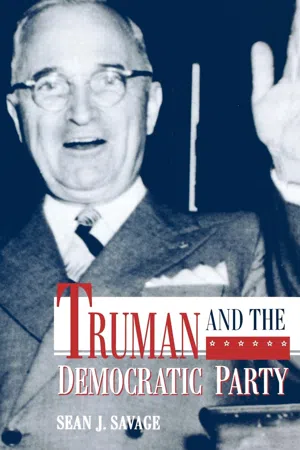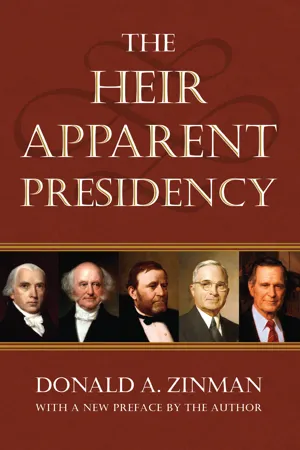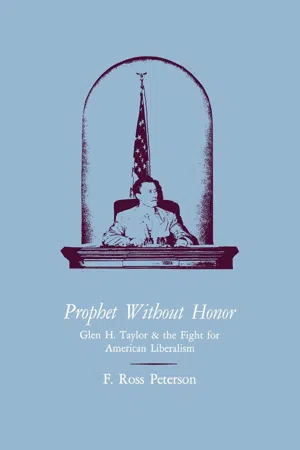History
Fair Deal
The Fair Deal was a set of domestic policies proposed by U.S. President Harry S. Truman in 1949. It aimed to extend the New Deal's social and economic programs, including initiatives for civil rights, healthcare, and education. Although many of the Fair Deal proposals were not fully implemented, it laid the groundwork for future social welfare and civil rights legislation in the United States.
Written by Perlego with AI-assistance
Related key terms
1 of 5
3 Key excerpts on "Fair Deal"
- eBook - ePub
- Sean J. Savage(Author)
- 2021(Publication Date)
- The University Press of Kentucky(Publisher)
8According to Clark M. Clifford, Truman coined the term Fair Deal when he revised the draft of his State of the Union Message.9 Clifford also claimed that the Fair Deal was intended to be an “analysis” or refinement of the New Deal, instead of merely a continuation of Roosevelt’s policies.10 Ironically, while some parts of the Fair Deal agenda, such as civil rights and national health insurance, were more liberal than the New Deal in that they sought greater federal intervention in these policy areas, the rhetoric and approach to Congress that Truman and his administration officials used were often more moderate and compromising than those of Roosevelt and his New Dealers.11There were several reasons for the relative moderation of the Fair Deal’s style in its articulation by Truman and his submission of its policy proposals to Congress. One was that while Truman wanted to increase federal spending in such domestic policy areas as education, health care, and housing, he also wanted to regularly reduce the national debt and maintain balanced budgets, which he accomplished three times during his presidency.12 Leon H. Keyserling, a member of the Council of Economic Advisers who became its chairman in 1950, was the chief articulator of and influence on Fair Deal economics.13 Like Raymond Moley, Rexford Tugwell, and other economic advisers in the early New Deal’s “Brain Trust,” he sought to encourage both economic growth and a broader, more equitable distribution of wealth and economic unity through economic planning and greater cooperation among government, business, and labor.14 - eBook - ePub
- Donald A. Zinman(Author)
- 2016(Publication Date)
- University Press of Kansas(Publisher)
39 After his victorious election in November, Truman once again asked Congress to pass the same civil rights legislation it had spurned in 1948. Now Truman packaged civil rights with his Fair Deal proposals. A far cry from Roosevelt’s occasional and sparsely enforced commitments to ending discrimination, Truman was the first president to hitch the cause of civil rights to a broader social welfare agenda. Truman’s program would not only build off of the institutions, policies, and principles of his predecessor’s agenda, but also make the machinery of government fairer to some of the Americans left behind by the New Deal. Subsequent Democratic presidents, most notably Johnson, followed Truman’s lead by fusing civil rights with broader commitments to economic security, upward mobility, and combating the root causes of poverty.Truman practiced the expansionist approach on the civil rights issue, but major legislation on this front died once again during his second term. Similar to Grant, Truman faced defeat on civil rights, and his vigor in pressing the issue with Congress waned in the final years of his presidency. Never straying from his public position in opposition to segregation, Truman started the process of bringing the principles of the civil rights agenda closer to the New Deal regime’s commitments to social justice. Discrimination in employment, military service, housing, and education all produced economic consequences for black Americans. Addressing the graduates of predominantly black Howard University in June 1952, Truman said, “Some of us are denied opportunity for economic reasons. Others are denied opportunity because of racial prejudice and discrimination. I want to see things worked out so that everyone who is capable of it receives a good education.”40 - eBook - ePub
Prophet Without Honor
Glen H. Taylor and the Fight for American Liberalism
- F. Ross Peterson(Author)
- 2021(Publication Date)
- The University Press of Kentucky(Publisher)
On July 31, 1945, thirteen senators, most of them liberals, met at a luncheon and mapped plans for enacting postwar legislation. Denying that they had discussed President Truman’s alleged drift toward the right, the group claimed their purpose was to see what liberal bills could be passed early in the fall. This group, which included Glen Taylor, wanted the resumption of federally sponsored reclamation projects, housing for veterans, controls on possible inflation, increased social security benefits, and full employment legislation. 18 Actually, Truman was as interested as the liberal Democratic senators in reviving the New Deal and he incorporated many of their suggestions in the legislative program which he sent to Congress on September 6, 1945, only four days after the Japanese formally surrendered. Calling for the demobilization of the armed forces as soon as possible, a return to peacetime production, and the continuation of price, rent, and wage controls in order to prevent inflation, Truman also requested, in his 16,000-word message, full employment legislation and a Fair Employment Practices Commission. Later he added health insurance, prepaid medical care, federal aid to education, the nationalization of atomic energy, and the development of the St. Lawrence Seaway. 19 In essence, Truman’s September proposals were the core of his Fair Deal program of domestic reform. Taylor and other liberals were heartened by these legislative suggestions, and the Idaho senator felt that he could successfully carry out his pledge to the “little man” as long as Truman continued to follow Roosevelt’s path. But President Truman’s legislative program did not receive such an enthusiastic reception in Congress as a whole. Robert Taft of Ohio led the opposition in the Senate; Joseph Martin of Massachusetts and Charles Hallack of Indiana, in the House
Index pages curate the most relevant extracts from our library of academic textbooks. They’ve been created using an in-house natural language model (NLM), each adding context and meaning to key research topics.


